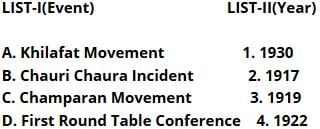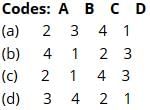History Test-2 - NDA MCQ
20 Questions MCQ Test - History Test-2
Who among the following are known as King Makers in Indian History ?
‘Amuktamalyada’ written by Krishnadeva Raya, the ruler of Vijayanagar, was in
Who of the following was the first Muslim President of Indian National Congress?
Who prescribed the separate electorates for India on the basis of the Communal Award in August 1932?
Under whose leadership was the Congress Socialist Party founded in 1934?
Who among the following drafted the resolution on Fundamental Rights for the Karachi Session of Congress in 1931?
Maulana Abul Kalam Azad started an urdu weekly, the Al-Hilal in ___________.
During India’s freedom struggle, which one of the following led to the first ‘All India Hartal’?
Match List-I with List-II and select the correct answer using the codes given below the Lists:





















